

Mr. Clean, advertising like a boss.
S Articles: Gardening in the Shade: what to plant if you don't have full sun. Still, many gardeners face the following dilemma: They want to grow vegetables and herbs, but don't have the required 6 hours of direct sunlight per day that most edible plants need.
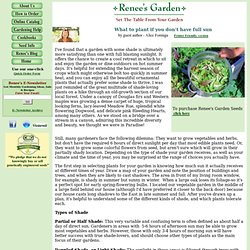
Or, they want to grow some colorful flowers from seed, but aren't sure which will grow in their partially shady location. Depending on the type of shade your garden receives, as well as your climate and the time of year, you may be surprised at the range of choices you actually have. The first step in selecting plants for your garden is knowing how much sun it actually receives at different times of year. Draw a map of your garden and note the position of buildings and trees, and when they are likely to cast shadows. The area in front of my living room window, for example, is shady in summer but sunny in winter. Types of Shade Partial or Half Shade: This very variable and confusing term is often defined as about half a day of direct sun. Dip Plant Stems and Cuttings in Cinnamon Before Planting to Prevent Fungal Infection. Cinnamon does not influence the rooting of the cutting - you still need the rooting compound for that.
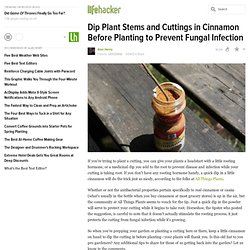
Cinnamon will help keep the cutting from rotting before it roots. Using cinnamon to prevent rotting is an old trick for anyone whose ever grown orchids. Yes, I got that from... "Horseshoe, the tipster who posted the suggestion, is careful to note that it doesn't actually stimulate the rooting process, it just protects the cutting from fungal infection while it's growing. " Mason Jar Herb Garden. Diy geoball.
LITTLE PLACE FOR MY PLANT. What Does the Leaf Says About Nutrient Deficiency Problem. Well, when you put it that way.. Planning and Building a Greenhouse. Adapted from Fact Sheet 645 - University of Maryland Cooperative Extension Service, David S.
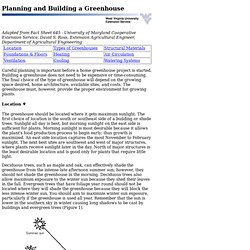
Ross, Extension Agricultural Engineer, Department of Agricultural Engineering. 40 Fruits, vegetables and herbs that will grow in partial shade - Mankato Green Culture. A Charleston Garden Blog: 10 Shade Tolerant Roses. Standard rose lingo has most of us believing that to grow a rose you need 6 plus hours of sunlight.

We'll I'm here to tell you it just isn't so! Many many roses will do totally fine with less than 6, and some frankly with less than 4 hours of sunlight. One of the unusual benefits to growing these shade tolerant types is that they tend to also be disease resistant types as well. Worm Compost Bin" Worm composting begins with a proper bin.
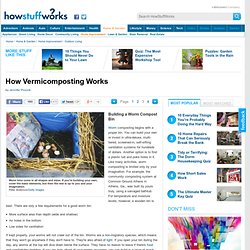
You can build your own or invest in ultra-deluxe, multi-tiered, screened-in, self-sifting ventilation systems for hundreds of dollars. Another option is to find a plastic tub and poke holes in it. Like many activities, worm composting is limited only by your imagination. For example, the community composting system at Common Ground Athens in Athens, Ga., was built by yours truly, using a salvaged bathtub. Tropaeolum tricolor. Tropaeolum tricolor, the three-coloured Indian cress, is a species of perennial plant in the family Tropaeolaceae.
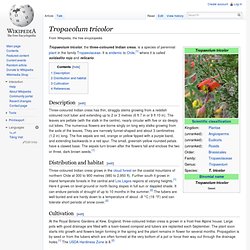
It is endemic to Chile,[1] where it is called soldadito rojo and relicario. Description[edit] Tropaeolum. The genus Tropaeolum, native to South and Central America, includes several very popular garden plants, the most commonly grown being T. majus, T. peregrinum and T. speciosum.

One of the hardiest species is T. polyphyllum from Chile, the perennial roots of which can survive the winter underground at altitudes of 3,300 metres (10,000 ft). History[edit] The first Tropaeolum species was imported into Spain by the Spanish botanist Nicolás Monardes. 42 flowers you can eat. The culinary use of flowers dates back thousands of years to the Chinese, Greek and Romans.
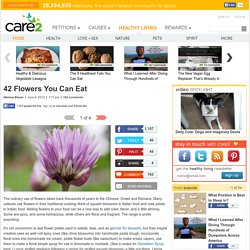
Many cultures use flowers in their traditional cooking–think of squash blossoms in Italian food and rose petals in Indian food. Acmella oleracea - Spilanthes - Better than Botox®? Acmella oleracea - Paracress - Still known under its old names Spilanthes oleracea and Spilanthes acmella and commonly referred to as Eyeball Plant, Peek-A-Boo Plant, Toothache Plant, Spot Plant, Prickelblume, Alphabet Plant, Jambu, Australian Cress, and Brazil Cress.
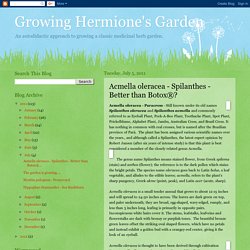
It has nothing in common with real cresses, but is named after the Brazilian province of Pará. The plant has been assigned various scientific names over the years., and although called a Spilanthes, the latest expert opinion by Robert Jansen (after six years of intense study) is that this plant is best considered a member of the closely related genus Acmella. The genus name Spilanthes means stained flower, from Greek spiloma (stain) and anthos (flower); the reference is to the dark pollen which stains the bright petals. Acmella oleracea is a small tender annual that grows to about 12-15 inches and will spread to 24-30 inches across. The flower heads are used fresh, dried and powdered. How to Make Lavender Water. Several years ago, a friend gave me a bottle of lavender water.

It came in a spritzer, and I used it to freshen napkins and pillowcases. The calming scent tiptoed into my dreams and I always awoke happy and refreshed. Well--most of the time. Vegetable Garden Plans. Good soil, adequate nutrients, water and sunlight are vital to a successful vegetable garden; these are indisputably the primary factors in the development of any plant.
It is your job as the Gardener to put all these elements together for the end goal of a bumper crop. Making a schematic or map of your garden is a good starting point. Familiarize yourself with your local climate and the vegetables and fruits that grow well best there, Keep track of the seasonal calendar. Dog food for fertilizer? - IDigMyGarden Forums. I like Jerry Baker's ideas, 'cause he thinks "outside the box," tries to help out gardeners rather than gardener-suppliers who overprice stuff, is a bit of a chemist and a bit of a lot of other things, and his stuff seems to WORK... and lots of gardeners believe in him ... I'd imagine 'cause they've tried some of his ideas and they worked. Also he's got a lot of ORGANIC rather than CHEMICAL solutions. Found two other websites about dog food for fertilizer ... and. Espalier.
A horizontal espalier Espalier (/ɨˈspælɪər/ or /ɨˈspæli.eɪ/) is the horticultural and ancient agricultural practice of controlling woody plant growth for the production of fruit, by pruning and tying branches to a frame, frequently in formal patterns, flat against a structure such as a wall, fence, or trellis, and also plants which have been shaped in this way.[1] Espaliers, trained into flat two-dimensional forms, are ideal not only for decorative purposes, but also for gardens in which space is limited. In a temperate climate, they may be planted next to a wall that can reflect more sunlight and retain heat overnight or planted so that they absorb maximum sunlight by training them parallel to the equator.
These two facts allow the season to be extended so that fruit has more time to mature. Wp-content/uploads/2011/03/F_GARD_ARTICLE.pdf. Plants. DIY Succulent Terrarium. I put together a succulent terrarium and it's the cutest thing ever. As such, I had to share it with you ladies! They can be used as table centerpieces or perhaps favors if you have a small guestlist. I had been seeing these little succulariums on Etsy where people are charging something like 30 bucks for them. I made mine for around $10! I found the candleholder at CB2 in San Francisco and thought it would make the perfect container: I was RIGHT! Starting Your Permaculture Garden. Most people passionate about living sustainably and harmoniously with nature will eventually stumble upon the system of Permaculture, it’s hard not to, it’s a world-wide phenomenon and it’s growing! If you’re reading this, then you’re one of these people!
Some of you will eventually study Permaculture, and then, on graduating, go through what we term the “Permaculture Effect”, a sense of deep and profound inner change or realisation, and a passion that follows from there, to go out there and make a difference, to stop being part of the problem and be part of the solution! The Atriplex Project: A Permaculture Database for the Front Range.
July 30, 2009. Garden design resources: Planting Calendar & Polyculture Web. January 31, 2010 As the skies clear over the Front Range and the air begins to warm (at least for now) my thoughts are turning increasingly to designing my garden for this year. Try No Dig Gardening for Your Backyard Vegetables. Permaculture Design Tips for Perennial Polycultures (Video)
Don't Get Busted or Robbed Growing Hydroponics Marijuana! Basic Types Grow Lights. Building a square foot garden. Where to build it Is the soil fertile enough? Raised beds and double-digging The lazy way Paths The sides Sizes and shapes Trellises Cement Soil No compost? Where to build it. Growing Sweet Potatoes in a Bag. Homesteading and Survivalism Store - Homesteading and Survivalism Store. How To Collect Basil Seeds - MrBrownThumb. Of all the edible plants people can grow in their gardens, or in containers, basil has to be the easiest of them all. No herb garden is complete without at least one basil plant growing. Building first real terrarium - Terrariums Forum. How to Mix Plants in a Vegetable Garden. Use One of These 4 Simple Garden Designs to Grow the 12 Best Kitchen Herbs - Organic Gardening.
Pineberry Plants for sale - Mow it Sow it Grow it - How to grow Pineberry plants. Welcome, Food Eater! - Karen Solomon. Upcoming Classes and Events. Which Smells or Herbs Will Repel Cats? Keeping Cats Out of the Garden.